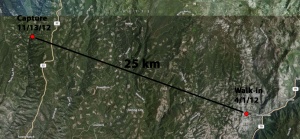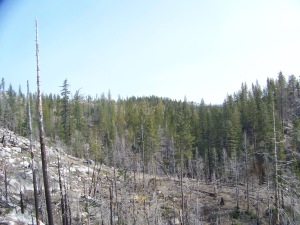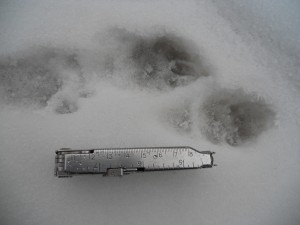One of the pleasant surprises during the fall trapping was recapturing an adult female, 1E003. She wasn’t captured the previous fall, so it was the first chance we had to examine her since her release nearly two years ago. Over the course of her time here, she has been a particularly challenging fisher to follow. A brief history of this fishers’ time on the Stirling district:
During the spring of 2011, three months after being translocated, she denned and had kits over in the far eastern portion of our study area (at the time further east than any other females we were tracking). This is a remote area of the district, and where she settled had fewer access roads than other areas. We failed to capture her during the fall of 2011, but were able to catch a juvenile in her home range. Through this past spring, we were still tracking her near her usual haunts on the eastern side of the district. We found her in trees within 100m of each other on several days and believed she was about to den. Then in mid-April, she vanished. Her collars’ batteries were due to expire at any time, so we figured that was what had happened. Thinking she had established a stable home range and would stay there, we weren’t expecting her to make any large movements.

Area covered during 1E003’s move from the east to the west.
Much to our surprise, during a June 2012 flight, we heard her signal again! This time however, she was on the complete other side of the district. Given the distance from where we normally heard this signal, we were skeptical that this was indeed our fisher. Instead, we thought it might be the transmitter of some other species associated with a project unknown to us. For much of June and July we continued to track and estimate the locations of the animal, but we could never confirm that it was a fisher by visually identifying it. Shortly thereafter, the collar disappeared from the airwaves again and we were left wondering if this was actually her or not. As mentioned above, we captured her during the trapping effort in November, indicating that she had probably been living in this new area, on the west side, since June. Sometime between April and June she made a 25km trek (as the crow flies) across the district and set up shop in a new area.

IE003 denning area near burn
Naturally, we were left wondering why an animal would make a huge move such as this. Immediately after being released, translocated fishers often roam around for a couple of months before they settle in an area. Often, juveniles and adult males make large movements as well, but this is more uncommon for an adult female.
This eastern side of the district is much rockier than other areas of the study area, and was hit by a large fire a few years ago. I remember being surprised the first time I went out there to look for her den that a fisher would settle in this area (you can see in the map the differences in the sides of the district). It is possible that the pressure of denning and giving birth made her pick and stick to a place that wasn’t ideal. Since she was released in January, she only had a couple of months to find a good place to den. She may have not had ample time to find the best possible place, and simply chose the best in the area she happened to be in.

1E003’s tracks from a few days ago.
The fact that she was able to survive, and likely raise kits, meant that she was getting enough food and other resources in the area. However, it could be that with kits reaching adulthood there wasn’t enough to go around. Possibly there was sufficient food, but maybe there was a paucity of mate choices (few males were known to frequent this area). Fact is, we will probably never know exactly why she decided to pick up and leave an area she had occupied for over a year, or why she made such a long move instead of finding an area much closer.
Today, I was able to find her in a rest tree, about a mile from where she was re-trapped. Since we captured her, we have been tracking her faithfully, and are starting to get a feel for the new areas she is using. We know there are a few other female fishers right around her, so it will be interesting to see how she fits in.



